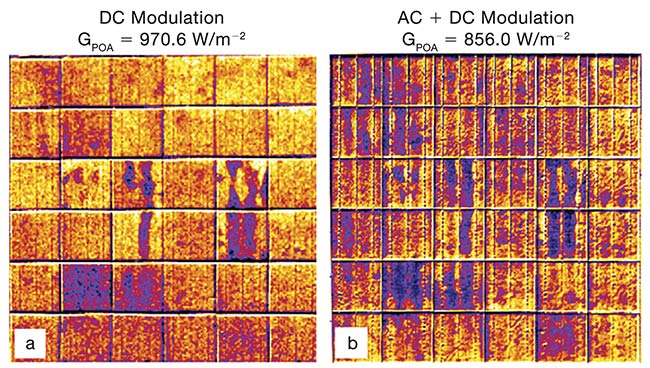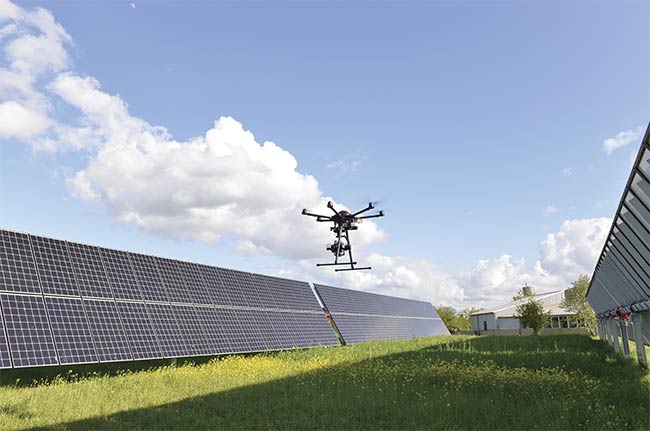HANK HOGAN, CONTRIBUTING EDITOR
Falling prices for solar panels, along with the desires of dozens of countries to reach renewable energy goals, led to an estimated 114.5 GW of global photovoltaic (PV) installations in 2019, according to energy market analyst
firm Wood Mackenzie. Global installation figures are projected to hover at ~125 GW per year through 2024.
Many of these installations involve utility-scale projects, which produce a megawatt or more of power. The number of panels needed in such projects runs in the thousands per megawatt, meaning a megawatt array can be spread out over four or five acres. As a cost-saving measure, the panels are usually electrically connected in series.

Shortwave IR (SWIR) imaging captures solar panel electroluminescence, which can be used to spot defects via a rapid scan of a panel. A moving drone image of outdoor panels in daylight, using DC electrical modulation (a). The results with AC and DC modulation (b). Darker areas indicate module faults or defects, while darkest areas correspond to module power loss due to severe solar cell cracks. GPOA: measured plane of array irradiance. Courtesy of Gisele Benatto and Peter Poulsen/DTU.
This can be a problem for installations in the field. “If you have one faulty cell in one module in a string of 20 or more modules, that faulty cell can decrease the power of the whole module, and decrease the power of the whole string of modules,” said Gisele Benatto, a postdoctoral researcher at the Technical University of Denmark (DTU) in Roskilde, Denmark.
Benatto was part of a team that demonstrated how these defects could be spotted using a new and potentially more effective method than has previously been available — a shortwave-infrared (SWIR) camera mounted on a drone. The group published the method and results in an IEEE Journal of Photovoltaics paper1, for which Benatto was the lead author.
Locating flaws in a solar farm installation is painstaking. One failing cell can only be easily isolated to a given string, which could be 20 or more modules or panels long. Determining which module contains a bad cell in a typical layout requires disconnecting and testing each panel individually.
Another option is to fly a thermal infrared camera over the solar array. The camera detects heat by capturing images at ~10-µm wavelength. This can be a rapid way to assess an entire field, but the approach only detects hot spots and therefore only picks up major problems.

Equipped with a camera that captures images in the SWIR, a drone inspects solar panels in
bright sunlight. Courtesy of Gisele Benatto and Peter Poulsen/DTU.
The DTU group’s new technique involves electroluminescence — the glow produced by photovoltaics in response to an applied voltage. This phenomenon can enable detection of cracks, broken interconnects, shunts, and other problems.
“Electroluminescence makes it possible to find a defect before it’s severe,” said Peter Poulsen, senior scientific officer at DTU and a co-author of the paper.
One problem with this technique, however, is that sunlight drowns out the electroluminescence produced by crystalline silicon PV cells, the most common type of solar cell. As a result, electroluminescence is typically only used for inspecting panels indoors or at night. The latter restriction prevents many PV installation inspections, however, due to nighttime access restrictions or safety issues.
To get around this, the researchers turned to a SWIR camera from Raptor Photonics Ltd. of Larne, Northern Ireland, with a SWIR wavelength range from ~0.9 to ~1.7 µm. The scientists mounted the 640- × 512-pixel InGaAs sensor-based camera on a drone and flew the system over a PV panel, collecting electroluminescence images in the 1125- to 1175-nm range at a rate of 120 fps. The imaging of each panel took only 1.7 s and was performed in full sunlight. Results showed that the technique can detect minor defects and could therefore help technicians do preventive maintenance of solar panels in the field.
Mark Donaghy, vice president of sales and marketing at Raptor Photonics, said the company also offers a higher-resolution camera. The camera used by the researchers was a better choice, however, because it worked within the power, weight, and size constraints needed to perform well while mounted on a drone.
“Because it’s small and lightweight and low power, it works very well,” Donaghy said of the off-the-shelf
camera that the researchers used.
He said that, with the proof of concept complete, the company may look into developing an even lighter, smaller, and more energy-efficient camera intended solely for inspection of PV installations. Commercial interest in such an application could be significant, Donaghy said.
DTU’s Poulsen said that its electroluminescence imaging system still needs software tools and a dedicated hardware package. The researchers are working with an integrator to further refine these and other aspects of the technology as part of a plan to get closer to commercial deployment.
Once this happens, the method may be useful for inspections beyond utility-scale PV installations. For instance, surveying solar panels mounted on buildings is currently a difficult task because it requires a specialized lift.
“It can be expensive and complicated to inspect stuff on a building,” Poulsen said. “Just to send up a drone makes it very fast and efficient. And safer.”
Reference
1. G. Benatto et al. (2020). Drone-based daylight electroluminescence imaging of PV modules. IEEE J Photovolt,
Vol. 10, Issue 3, pp. 872-877.